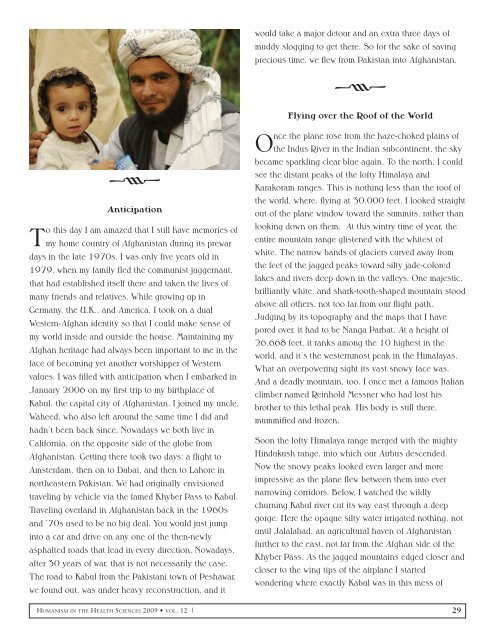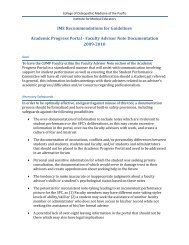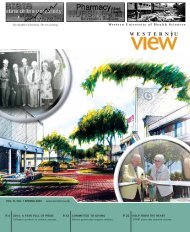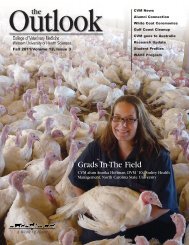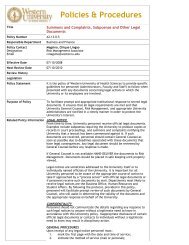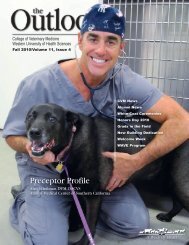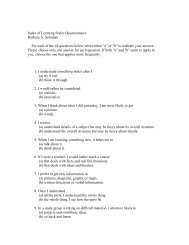Humanism 2009 - Western University of Health Sciences
Humanism 2009 - Western University of Health Sciences
Humanism 2009 - Western University of Health Sciences
You also want an ePaper? Increase the reach of your titles
YUMPU automatically turns print PDFs into web optimized ePapers that Google loves.
�<br />
Anticipation<br />
To this day I am amazed that I still have memories <strong>of</strong><br />
my home country <strong>of</strong> Afghanistan during its prewar<br />
days in the late 1970s. I was only five years old in<br />
1979, when my family fled the communist juggernaut,<br />
that had established itself there and taken the lives <strong>of</strong><br />
many friends and relatives. While growing up in<br />
Germany, the U.K., and America, I took on a dual<br />
<strong>Western</strong>-Afghan identity so that I could make sense <strong>of</strong><br />
my world inside and outside the house. Maintaining my<br />
Afghan heritage had always been important to me in the<br />
face <strong>of</strong> becoming yet another worshipper <strong>of</strong> <strong>Western</strong><br />
values. I was filled with anticipation when I embarked in<br />
January 2006 on my first trip to my birthplace <strong>of</strong><br />
Kabul, the capital city <strong>of</strong> Afghanistan. I joined my uncle,<br />
Waheed, who also left around the same time I did and<br />
hadn’t been back since. Nowadays we both live in<br />
California, on the opposite side <strong>of</strong> the globe from<br />
Afghanistan. Getting there took two days: a flight to<br />
Amsterdam, then on to Dubai, and then to Lahore in<br />
northeastern Pakistan. We had originally envisioned<br />
traveling by vehicle via the famed Khyber Pass to Kabul.<br />
Traveling overland in Afghanistan back in the 1960s<br />
and ’70s used to be no big deal. You would just jump<br />
into a car and drive on any one <strong>of</strong> the then-newly<br />
asphalted roads that lead in every direction. Nowadays,<br />
after 30 years <strong>of</strong> war, that is not necessarily the case.<br />
The road to Kabul from the Pakistani town <strong>of</strong> Peshawar,<br />
we found out, was under heavy reconstruction, and it<br />
would take a major detour and an extra three days <strong>of</strong><br />
muddy slogging to get there. So for the sake <strong>of</strong> saving<br />
precious time, we flew from Pakistan into Afghanistan.<br />
�<br />
Flying over the Ro<strong>of</strong> <strong>of</strong> the World<br />
Once the plane rose from the haze-choked plains <strong>of</strong><br />
the Indus River in the Indian subcontinent, the sky<br />
became sparkling clear blue again. To the north, I could<br />
see the distant peaks <strong>of</strong> the l<strong>of</strong>ty Himalaya and<br />
Karakoram ranges. This is nothing less than the ro<strong>of</strong> <strong>of</strong><br />
the world, where, flying at 30,000 feet, I looked straight<br />
out <strong>of</strong> the plane window toward the summits, rather than<br />
looking down on them. At this wintry time <strong>of</strong> year, the<br />
entire mountain range glistened with the whitest <strong>of</strong><br />
white. The narrow bands <strong>of</strong> glaciers curved away from<br />
the feet <strong>of</strong> the jagged peaks toward silty jade-colored<br />
lakes and rivers deep down in the valleys. One majestic,<br />
brilliantly white, and shark-tooth-shaped mountain stood<br />
above all others, not too far from our flight path.<br />
Judging by its topography and the maps that I have<br />
pored over, it had to be Nanga Parbat. At a height <strong>of</strong><br />
26,668 feet, it ranks among the 10 highest in the<br />
world, and it’s the westernmost peak in the Himalayas.<br />
What an overpowering sight its vast snowy face was.<br />
And a deadly mountain, too. I once met a famous Italian<br />
climber named Reinhold Messner who had lost his<br />
brother to this lethal peak. His body is still there,<br />
mummified and frozen.<br />
Soon the l<strong>of</strong>ty Himalaya range merged with the mighty<br />
Hindukush range, into which our Airbus descended.<br />
Now the snowy peaks looked even larger and more<br />
impressive as the plane flew between them into ever<br />
narrowing corridors. Below, I watched the wildly<br />
churning Kabul river cut its way east through a deep<br />
gorge. Here the opaque silty water irrigated nothing, not<br />
until Jalalabad, an agricultural haven <strong>of</strong> Afghanistan<br />
further to the east, not far from the Afghan side <strong>of</strong> the<br />
Khyber Pass. As the jagged mountains edged closer and<br />
closer to the wing tips <strong>of</strong> the airplane I started<br />
wondering where exactly Kabul was in this mess <strong>of</strong><br />
HUMANISM IN THE HEALTH SCIENCES <strong>2009</strong> • VOL. 12 | 29


